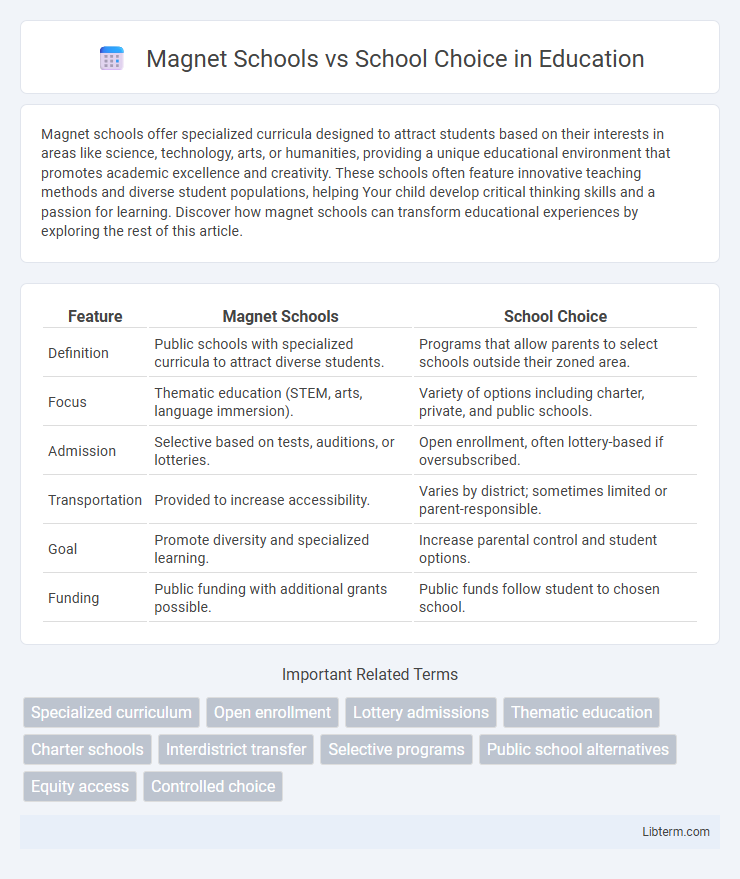Magnet schools offer specialized curricula designed to attract students based on their interests in areas like science, technology, arts, or humanities, providing a unique educational environment that promotes academic excellence and creativity. These schools often feature innovative teaching methods and diverse student populations, helping Your child develop critical thinking skills and a passion for learning. Discover how magnet schools can transform educational experiences by exploring the rest of this article.
Table of Comparison
| Feature | Magnet Schools | School Choice |
|---|---|---|
| Definition | Public schools with specialized curricula to attract diverse students. | Programs that allow parents to select schools outside their zoned area. |
| Focus | Thematic education (STEM, arts, language immersion). | Variety of options including charter, private, and public schools. |
| Admission | Selective based on tests, auditions, or lotteries. | Open enrollment, often lottery-based if oversubscribed. |
| Transportation | Provided to increase accessibility. | Varies by district; sometimes limited or parent-responsible. |
| Goal | Promote diversity and specialized learning. | Increase parental control and student options. |
| Funding | Public funding with additional grants possible. | Public funds follow student to chosen school. |
Introduction to Magnet Schools and School Choice
Magnet schools are public educational institutions designed to attract a diverse student body through specialized curricula such as STEM, performing arts, or language immersion programs, aiming to promote academic excellence and cultural integration. School choice encompasses a broader range of options, including charter schools, private schools, vouchers, and open enrollment policies, allowing parents to select the best educational environment for their children beyond traditional district boundaries. Both magnet schools and school choice initiatives seek to improve student outcomes by providing tailored learning opportunities and increased access to quality education.
Historical Background of Magnet Schools
Magnet schools originated in the 1960s as a federal initiative to desegregate public education by attracting a diverse student body with specialized curricula in science, arts, and technology. These schools were designed to promote voluntary integration and educational innovation, offering distinct programs not available in traditional public schools. Over time, magnet schools have evolved into centers of excellence that emphasize both academic rigor and cultural diversity, differing from broader school choice options that primarily focus on parental selection rather than targeted desegregation efforts.
Defining School Choice: Types and Models
School choice encompasses various models allowing families to select educational options beyond assigned public schools, including charter schools, voucher programs, open enrollment policies, and magnet schools. Magnet schools represent a specialized subset of school choice, featuring themed curricula designed to attract diverse student populations district-wide. Voucher programs enable parents to use public funds for private schooling, while open enrollment permits students to attend public schools outside their zoned area.
Admission Processes: Magnet Schools vs School Choice
Magnet schools implement a selective admission process based on academic performance, talents, or interests to create specialized learning environments, often requiring applications, tests, or auditions. School choice programs offer broader admission options with less stringent criteria, allowing families to select public, charter, or private schools regardless of district boundaries, emphasizing equitable access. Understanding these differences helps parents evaluate opportunities, weighing the competitive entry of magnet schools against the diverse options available through school choice.
Curriculum Differences and Educational Focus
Magnet schools emphasize specialized curricula centered on themes like STEM, performing arts, or language immersion, designed to attract students with specific interests and talents. School choice programs offer families a broader selection of public, charter, and sometimes private schools, each with unique educational focuses tailored to diverse learning needs. Curriculum differences highlight magnet schools' theme-based approach versus the varied pedagogical styles and program emphases available through school choice options.
Diversity and Student Demographics
Magnet schools often promote diversity by offering specialized curricula that attract students from various racial, ethnic, and socioeconomic backgrounds, creating integrated learning environments. School choice policies can either enhance or limit diversity depending on factors like transportation accessibility and admission criteria, potentially leading to demographic imbalances. Data from the National Center for Education Statistics shows that magnet schools enroll a higher percentage of minority students compared to traditional public schools with school choice options.
Academic Outcomes and Performance
Magnet schools consistently demonstrate higher academic outcomes compared to general school choice options, with students showing improved standardized test scores and graduation rates due to specialized curricula and selective admissions. Research indicates magnet programs foster enhanced student engagement and advanced course offerings, leading to better performance in STEM and arts disciplines. Conversely, broader school choice models produce mixed academic results, as variability in resources and teaching quality affects student achievement across different settings.
Parental Involvement and Community Impact
Magnet schools often foster higher parental involvement through specialized curricula that align with parents' educational priorities, enhancing student engagement and academic outcomes. School choice programs broaden access to diverse educational settings, encouraging community investment and competition that can drive overall school improvement. Both approaches influence community dynamics by shaping local school demographics and resource allocation, impacting neighborhood cohesion and educational equity.
Funding and Resource Allocation
Magnet schools typically receive targeted federal and state funding to support specialized curricula, which can lead to enhanced resources for STEM and arts programs compared to traditional public schools. School choice policies often redirect public funds through vouchers or charter systems, potentially creating funding disparities by shifting resources away from neighborhood schools. This reallocation can impact equitable access to quality education, as magnet schools benefit from concentrated investments while choice mechanisms may dilute overall funding.
Pros, Cons, and Key Considerations
Magnet schools offer specialized curricula and advanced academic programs that attract diverse student populations but may limit access due to competitive admissions and geographic restrictions. School choice provides families with options like charter schools, private schools, or homeschooling, promoting personalized education but potentially leading to funding disparities and unequal resource distribution in public schools. Key considerations include evaluating academic quality, equity of access, transportation logistics, and long-term impacts on community school stability.
Magnet Schools Infographic

 libterm.com
libterm.com